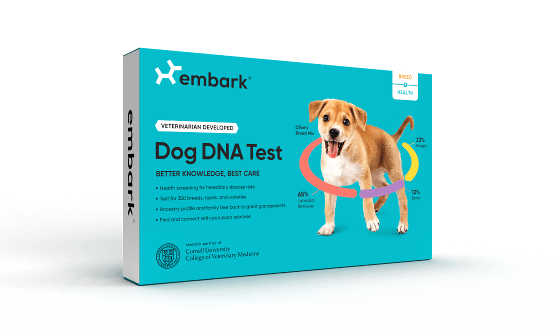Embark offers the world’s first and only canine relative finder, so you can further explore your dog’s DNA story. Our Relative Finder shows your dog’s relatives based on how much DNA they share. It also gives you the ability to connect with their owners. In fact, it has already led to several family reunions, like Vardis and his long-lost sister Brunch and brothers Rowan and Milo!
Read on to learn how to use the Relative Finder to find your dog’s DNA relatives.
How does Embark find my dog’s relatives?
Embark analyzes your dog’s genome to find sections of DNA that are shared between your dog and other dogs. Generally, the more DNA they share, the more closely related they are.
Why is it important to find my dog’s relatives?
Connecting with your dog’s relatives can be helpful for your dog’s health the same way a family history helps humans manage our health. When owners with related dogs share information about conditions they’ve observed in their dogs, it can help both of them be better informed and proactive about their dogs’ health.
There’s a lot we still don’t know about the genetic roots for some diseases. The more genetic information we can collect about the genes that dogs share, the more health discoveries we can make.
Where can I see my dog’s relatives?
In your dog’s Embark profile, click the Relatives tab to see all your dog’s genetic relatives, from most closely related to distantly related. We’ll update this page as we test more dogs and find new relatives. (Relative Finder is available for dogs tested with a Breed ID, Breed + Health, or Purebred Kit.)

The Relative Finder shows you how closely related your dog may be to other dogs, in human terms—“as related as” human cousins, for example. But just because two dogs are “as related as” human siblings doesn’t always mean that they are from the same litter. It turns out that estimating the actual relationships between two dogs from genetics alone is more difficult in dogs than it is in humans.
In general, we consider mixed-breed dogs who share about half their DNA “as related as” siblings or a parent/child pair. DNA matches less than 50% indicate extended family (although this is not always the case! Unrelated dogs can sometimes share DNA, too, if they have a similar breed mix).
For purebred dogs, things are a little different. All purebred dogs within a breed are closely related. By default, they share more DNA than mixed-breed dogs. If you have a purebred dog, you’ll likely see a long list of genetic relatives. That doesn’t mean all those dogs are siblings. It just means that they have a lot of DNA in common. If your purebred dog really does have a close relative, you’ll often see that that relative has a very high percentage of shared DNA (sometimes even 70–80%).
Do my dog’s relatives share DNA like human siblings?
Family ties can be a little more complicated in dogs than in humans.
Genetic relatedness is the fraction of two dogs’ genomes that descend from the same ancestor(s). You probably already know that you are 50% genetically identical to each of your biological parents. Your siblings are, on average, 50% identical to you. (We say “on average,” because sometimes DNA can be mixed up and rearranged before it is passed down in a process called recombination.) Going further out, you are about 25% related to your aunts, uncles, and grandparents, 12.5% related to your first cousins, 3.125% related to your second cousins, and so on.
So, if your dog is about 12.5% related to another dog, does that mean that they are first cousins? It’s not quite that simple.
Just because two dogs are “as related as” first cousins doesn’t mean that they have that exact relationship. This is particularly true for purebred dogs, where a limited number of founder individuals created the breed, fairly recently in time. Because of this history of inbreeding, all dogs in a breed may be as related as first cousins (or even more so in some breeds), not because they are actually first cousins, but because they are third or fourth cousins several times over. For example, the figure below shows a pedigree for two purebred dogs. These two dogs would have results that say they are “as related as” second cousins, but they are actually quadruple third cousins (they have 12 instead of 16 great-grandparents).

Because of the tremendous variation in the amount and duration of inbreeding in dog populations, it’s harder to predict the relationship between two related dogs than it is in humans. As we collect more data, we’re working to improve this area of science and upgrade our Relative Finder over time. Until then, we hope you enjoy exploring this feature and connecting with your dog’s relatives.









